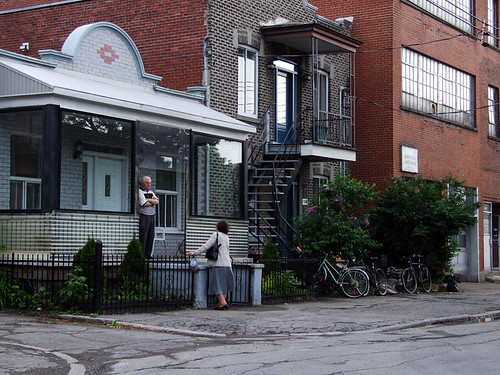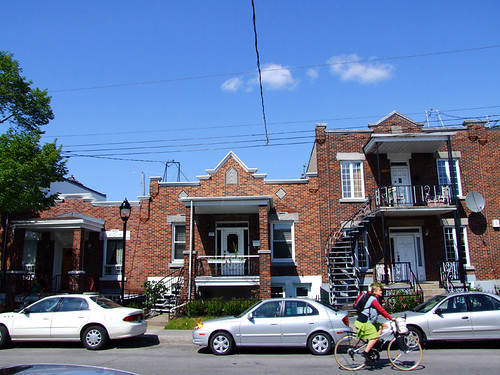I’ve always been curious about the flat-roofed one-storey houses that are sprinkled throughout many of Montreal’s neighbourhoods. Rather than traditional bungalows, they look more like growth-stunted plexes that are missing their upper floors. Last Friday’s Gazette featured a nice feature by Susan Semenak on the houses, looking both at their history and their current popularity with home buyers looking for an in-town single-family house. I never realized they had a name: shoebox houses. (It’s cute, but I prefer “hobbit houses,” which is what one Urbanphoto commenter called them.)
Most shoebox houses are found in neighbourhoods like Verdun, lower NDG, Villeray and Ahuntsic, which were opened to development with the spread of Montreal’s electric tramway. They appealed mainly to working-class families that couldn’t afford to build proper duplexes or triplexes but still wanted a house of their own. According to David Hanna, an urban studies professor at UQAM and Montreal’s plex expert, they could be built for as little at $500 if family members helped with construction. (That’s about $9,500 in today’s money, according to the Bank of Canada’s inflation calculator.) The houses were designed to be expandable, so that a second storey could be eventually be added, a piecemeal process similar to the way houses are built in many of the world’s developing countries.
That kind of independent house construction has vanished in Montreal, as land and construction prices soared and the house-building trade became dominated by professional real estate developers. And even though shoebox houses might be enjoying a resurgence in popularity, they’re also being knocked down for new condominium developments, a trend documented by Guillaume St-Jean here on Spacing Montreal and in his series of then-and-now photos. My feelings about this are mixed: on one hand, densification is a natural, desirable trend, but on the other, we’re losing an historically important type of house that remains an affordable entry into homeownership.




7 comments
Take the Metro to Joliquer and walk up that street. You will find a treasure trove of these structures in Cote Saint Paul.
I love that last photo with the tiny, small, and bigger version on the “same” house. Nice work!
I believe there are quite a few of these out East too, in the Longue-Pointe district (South of Honoré-Beaugrand metro).
Although there were more even 15 years ago, there are a few in the bowels of Saint-Henri, notably the wedge-shaped “ship” house by the tracks at Saint-Remi mentioned in “Bonheur d’Occasion”.
These kind of houses were also frequently built in my home town, Hamilton, ON, back in the day – there’s still lots around the working-class North End.
They look goot. Too small but very cosy and cute. I think a young couple can live in such house with a pleasure.
On en trouve plusieurs à Ville-Émard. Quelques unes sont intéressantes et d’autres amusantes parce que leur propriétaire se sont bien appropriés du lieu, mais certaines de ces maisons sont visuellement sans intérêts, sinon socio-historique.
I think they would be wonderful for 50’s + wanting to downsize. not everyone wants the condo route.I mysely am keeping my eyes peeled for a suitable……
how much would you pay for one with front landscape, driveway, and 12 x 10 concrete back pateo plus garden area?